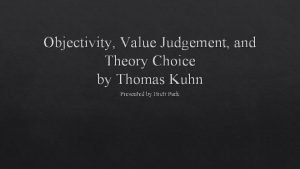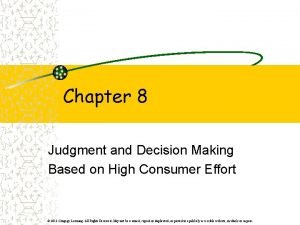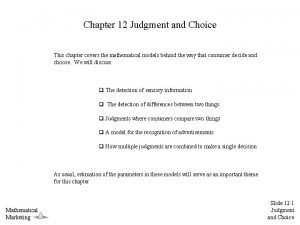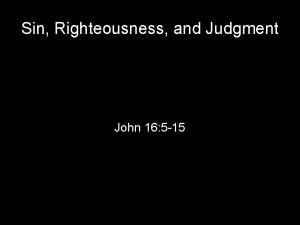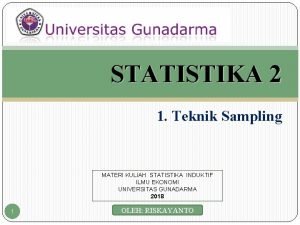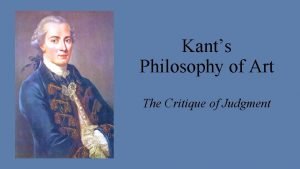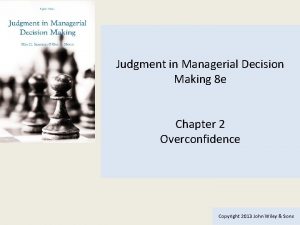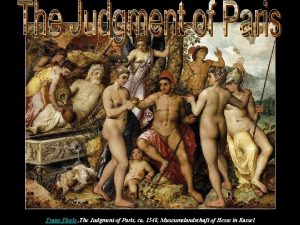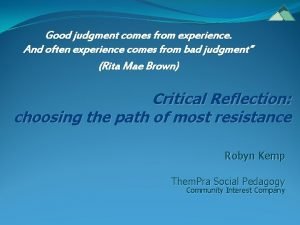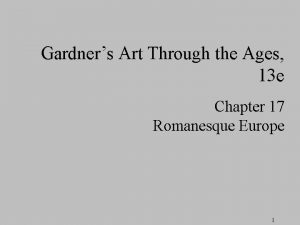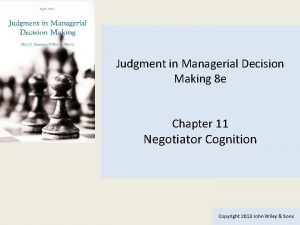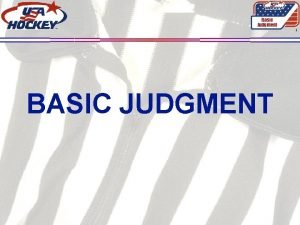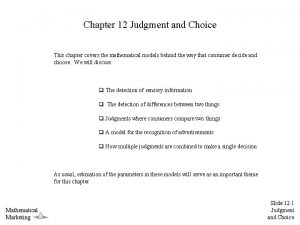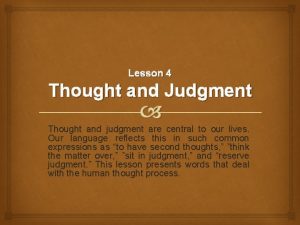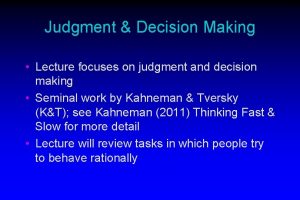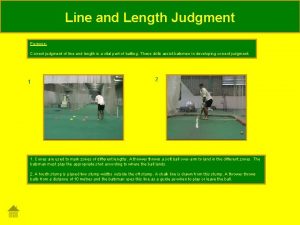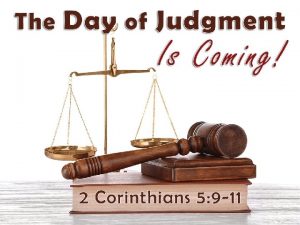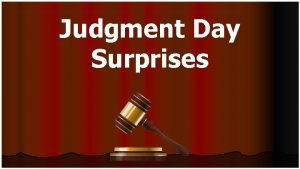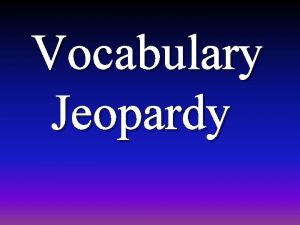Chapter 12 Judgment and Choice This chapter covers













![Predicting Choice Probabilities For a ~ N[E(a), V(a)] we have Pr [a 0] = Predicting Choice Probabilities For a ~ N[E(a), V(a)] we have Pr [a 0] =](https://slidetodoc.com/presentation_image/0c27e0fad83d06fe37fd1949994176aa/image-14.jpg)








![Categorical or Absolute Judgment Love [ ] Like [ ] Dislike [ ] s Categorical or Absolute Judgment Love [ ] Like [ ] Dislike [ ] s](https://slidetodoc.com/presentation_image/0c27e0fad83d06fe37fd1949994176aa/image-23.jpg)



![The Probability of Using a Specific Category (or Less) Pr [a 0] = [E(a) The Probability of Using a Specific Category (or Less) Pr [a 0] = [E(a)](https://slidetodoc.com/presentation_image/0c27e0fad83d06fe37fd1949994176aa/image-27.jpg)

- Slides: 28

Chapter 12 Judgment and Choice This chapter covers the mathematical models behind the way that consumer decide and choose. We will discuss q The detection of sensory information q The detection of differences between two things q Judgments where consumers compare two things q A model for the recognition of advertisements q How multiple judgments are combined to make a single decision As usual, estimation of the parameters in these models will serve as an important theme for this chapter Mathematical Marketing Slide 12. 1 Judgment and Choice

There Are Two Different Types of Judgments q Absolute Judgment • • Do I see anything? How much do I like that? q Comparative Judgment • • Does this bagel taste better than that one? Do I like Country Time Lemonade better than Minute Maid? Psychologists began investigating how people answer these sorts of questions in the 19 th Century Mathematical Marketing Slide 12. 2 Judgment and Choice

The Early Concept of a “Threshold” Absolute Detection 1. 0 Pr(Detect). 5 0 n Physical measurement Difference Detection 1. 0 Pr(n Perceived > n 2). 5 0 n 1 Mathematical Marketing n 2 n 3 Slide 12. 3 Judgment and Choice

But the Data Never Looked Like That 1. 0 Pr(Detect) . 5 0 Mathematical Marketing n Slide 12. 4 Judgment and Choice

A Simple Model for Detection si is the psychological impact of stimulus i If si exceeds the threshold, you see/hear/feel it We make this assumption Pr[Detect stimulus i] = Pr[si s 0]. ei ~ N(0, 2) so that which then implies We also assume Mathematical Marketing Slide 12. 5 Judgment and Choice

Our Assumptions Imply That the Probability of Detection Is… (Note missing left bracket in Equation 12. 6 in book. ) Converting to a z-score we get (Note missing subscript i on the z in book) Mathematical Marketing Slide 12. 6 Judgment and Choice

Making the Equation Simpler But since the normal distribution is symmetric about 0 we can say: Mathematical Marketing Slide 12. 7 Judgment and Choice

Graphical Picture of What We Just Did 0 Pr(Detection) Mathematical Marketing 0 Slide 12. 8 Judgment and Choice

A General Rule for Pr(a > 0) Where a Is Normally Distributed For a ~ N[E(a), V(a)] we have Pr [a 0] = [E(a) / V(a)] Mathematical Marketing Slide 12. 9 Judgment and Choice

So Why Do Detection Probabilities Not Look Like a Step Function? Mathematical Marketing Slide 12. 10 Judgment and Choice

Paired Comparison Data: Pr(Row Brand > Column Brand) Mathematical Marketing A B C A - . 6 . 7 B . 4 - . 2 C . 3 . 8 - Slide 12. 11 Judgment and Choice

Assumptions of the Thurstone Model ei ~ N(0, ) Cov(ei, ej) = ij = r i j Draw si Draw sj Is si > sj? Mathematical Marketing Slide 12. 12 Judgment and Choice

Deriving the E(si - sj) and V (si - sj) pij = Pr(si > sj ) = Pr(si - sj > 0) Mathematical Marketing Slide 12. 13 Judgment and Choice
![Predicting Choice Probabilities For a NEa Va we have Pr a 0 Predicting Choice Probabilities For a ~ N[E(a), V(a)] we have Pr [a 0] =](https://slidetodoc.com/presentation_image/0c27e0fad83d06fe37fd1949994176aa/image-14.jpg)
Predicting Choice Probabilities For a ~ N[E(a), V(a)] we have Pr [a 0] = [E(a) / V(a)] Below si - sj plays the role of "a" Mathematical Marketing Slide 12. 14 Judgment and Choice

Thurstone Case III =0 =1 How many unknowns are there? How many data points are there? Mathematical Marketing Slide 12. 15 Judgment and Choice

Unweighted Least Squares Estimation Mathematical Marketing Slide 12. 16 Judgment and Choice

Conditions Needed for Minimizing f Mathematical Marketing Slide 12. 17 Judgment and Choice

Minimum Pearson 2 Same model: Different objective function Mathematical Marketing Slide 12. 18 Judgment and Choice

Matrix Setup for Minimum Pearson 2 V(p) = V Mathematical Marketing Slide 12. 19 Judgment and Choice

Minimum Pearson 2 Modified Minimum Pearson 2 Simplifies the derivatives, and reduces the computational time required Mathematical Marketing Slide 12. 20 Judgment and Choice

Definitions and Background for ML Estimation Assume that we have two possible events A and B. The probability of A is Pr(A), and the probability of B is Pr(B). What are the odds of two A's on two independent trials? Pr(A) • Pr(A) = Pr(A)2 In general the Probability of p A's and q B's would be Note these definitions and identities: fij = npij Mathematical Marketing Slide 12. 21 Judgment and Choice

ML Estimation of the Thurstone Model According to the Model Mathematical Marketing According to the general alternative Slide 12. 22 Judgment and Choice
![Categorical or Absolute Judgment Love Like Dislike s Categorical or Absolute Judgment Love [ ] Like [ ] Dislike [ ] s](https://slidetodoc.com/presentation_image/0c27e0fad83d06fe37fd1949994176aa/image-23.jpg)
Categorical or Absolute Judgment Love [ ] Like [ ] Dislike [ ] s 1 1 Love Brand 1 Brand 2 Brand 3 Mathematical Marketing . 20. 10. 05 2 Like. 30. 10 s 2 3 Hate [ ] s 3 4 Dislike. 20. 60. 15 Hate. 30. 20. 70 Slide 12. 23 Judgment and Choice

Cumulated Category Probabilities Love Brand 1. 20 Raw Probabilities Cumulated Probabilities Mathematical Marketing Like. 30 Dislike. 20 Hate. 30 Brand 2 . 10 . 60 . 20 Brand 3 . 05 . 10 . 15 . 70 Brand 1 . 20 . 50 . 70 1. 00 Brand 2 . 10 . 20 . 80 1. 00 Brand 3 . 05 . 15 . 30 1. 00 Slide 12. 24 Judgment and Choice

The Thresholds or Cutoffs c 0 = - Mathematical Marketing c 1 c 2 c 3 (c. J-1) c 4 = + Slide 12. 25 Judgment and Choice

A Model for Categorical Data ei ~ N(0, 2) Probability that item i is placed in category j or less Mathematical Marketing Probability that the discriminal response to item i is less than the upper boundary for category j Slide 12. 26 Judgment and Choice
![The Probability of Using a Specific Category or Less Pr a 0 Ea The Probability of Using a Specific Category (or Less) Pr [a 0] = [E(a)](https://slidetodoc.com/presentation_image/0c27e0fad83d06fe37fd1949994176aa/image-27.jpg)
The Probability of Using a Specific Category (or Less) Pr [a 0] = [E(a) / V(a)] Below ci - sj is plays the role of "a" Mathematical Marketing Slide 12. 27 Judgment and Choice

The Theory of Signal Detectability Response Reality Mathematical Marketing S N S Hit Miss N False Alarm Correct Rejection Slide 12. 28 Judgment and Choice
 Objectivity value judgment and theory choice
Objectivity value judgment and theory choice Good choice or bad choice
Good choice or bad choice Judgment chapter 8
Judgment chapter 8 Judgment chapter 12
Judgment chapter 12 John 16:8
John 16:8 Critical judgment and continuous monitoring are examples of
Critical judgment and continuous monitoring are examples of Apa itu judgement sampling
Apa itu judgement sampling Ncsbn clinical judgement measurement model
Ncsbn clinical judgement measurement model Summary judgment definition
Summary judgment definition Golden apple trojan war
Golden apple trojan war Art as a disinterested judgement ppt
Art as a disinterested judgement ppt Judgment in managerial decision making 8th edition
Judgment in managerial decision making 8th edition Musee picasso
Musee picasso Clinical judgment definition
Clinical judgment definition Muzafer sherif theory
Muzafer sherif theory Good judgment comes from experience
Good judgment comes from experience Gislebertus last judgment
Gislebertus last judgment Judgment massage
Judgment massage Jacob de backer last judgment
Jacob de backer last judgment John 7;24
John 7;24 Judgment seat of christ
Judgment seat of christ Example of value judgment
Example of value judgment Three-skill approach
Three-skill approach Mythical fixed pie assumption
Mythical fixed pie assumption It leads the balance wheel through the belt connection
It leads the balance wheel through the belt connection What ports are defined above 49 152
What ports are defined above 49 152 Covers body surfaces and lines body cavities
Covers body surfaces and lines body cavities A thin fold of skin that covers and protects the human eye
A thin fold of skin that covers and protects the human eye Ch 56 oral and maxillofacial surgery
Ch 56 oral and maxillofacial surgery
